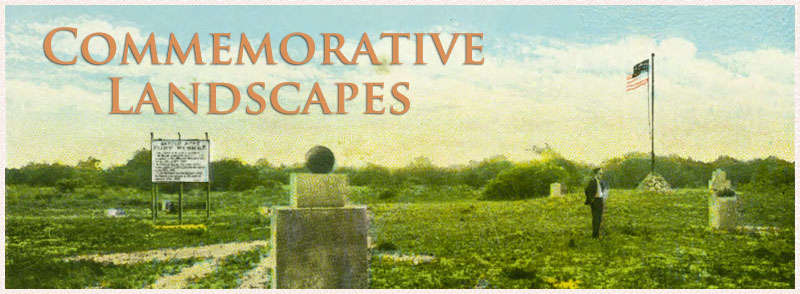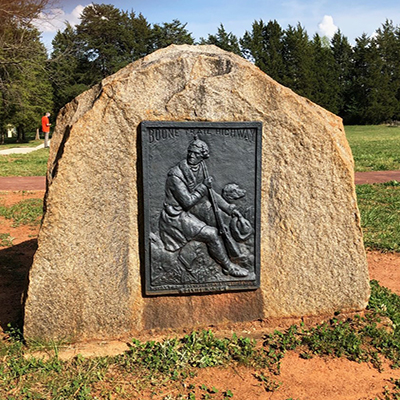
Boone Trail Highway Marker (#29A), Statesville
This Boone Highway marker is a Style-3 tablet placed in 1928 on the north face of the Fort Dobbs marker dedicated in 1910 by the Daughters of the American Revolution. The steel Style-3 tablet was primarily used between 1927 and 1938 and is distinguished by the BOONE TRAIL HIGHWAY caption being slightly curved. It holds an image in relief taken from Alonzo Chapel’s 1861 illustration of Daniel Boone and his hunting dog. The Ft. Dobbs marker is a large oval shaped granite boulder standing about three feet high.
This Boone Highway marker was numbered 29A by Everett G. Marshall. His interest and research of the markers led to the book, Rich Man: Daniel Boone. The numbering system was simply the order in which he found or became aware of a marker.
Images:
Tablet |
Far-off view |
View with the fort |
View with the Visitor center
Tablet, top: BOONE TRAIL HIGHWAY
Bottom: METAL FROM BATTLESHIP MAINE IN TABLET / DANIEL BOONE
North Carolina State Historic site
June 19, 1928
35.821050 , -80.897320
View in Geobrowse
"J. Hampton Rich," from the "Images of North Carolina" digital collection, Davie County Public Library, (accessed January 21, 2015) Link
"Site of Fort Dobbs," The Historical Marker Database, HMdb.org, (accessed May 26, 2017) Link
Jones Randell. “Markers for Boone’s Trail Have Rich History,” Winston-Salem Journal (Winston-Salem, NC), November 26, 2013, (accessed February 15, 2017) Link
Jones, H.G. “Rich, Joseph Hampton,” NCPedia.org, (accessed March 22, 1917) Link
Marshall, Everett G. Rich Man: Daniel Boone (Dugspur, VA: Sugar Tree Enterprises, 2003)
Stanford, Raney. “Shades of Dan’l Boone! Says J.H. Rich,” The Daily Tarheel (Chapel Hill, NC), February 8, 1948
“A Daniel Boone Marker Unveiled,” Statesville Record And Landmark (Statesville, NC), June 21, 1928
“Daniel Boone Marker #29 – Statesville, North Carolina,” Waymarking.com, (accessed March 14, 2017) Link
“The Boone Tablet,” Winston Salem Journal (Winston-Salem, NC), May 17, 1916
Yes
Steel, granite
Boone Trail Highway and Memorial Association, Fort Dobbs Chapter Daughters of the American Revolution
The ceremony opened with the American creed and flag salute by members of the Fort Dobbs Chapter Daughters of the American Revolution and guests. J. Hampton Rich gave a short talk on Fort Dobbs and Daniel Boone prior to the unveiling.
J. Hampton Rich was a well-known figure in North Carolina’s “Good
Roads Movement” during the early 20th Century when public pressure
was used to force enhancements in the public highway system.
Attaining minor celebrity status he eventually extended his vision
beyond the borders of his home state. Using the legacy of Daniel
Boone as a hook, he first began to cross North Carolina and then the
United States drumming up support for commemorative highway markers.
Between 1917 and 1938 Rich was one of the most prolific commemorators
in the United States. He claimed responsibility for hundreds of
markers, some in places that had no connection to Boone at all like
Washington, D.C.; Boston, Massachusetts; Pike’s Peak, Colorado and at
the Golden Gate Bridge in San Francisco.
Rich was born in 1874 on land where the family of Daniel Boone may
have once lived. What is certain though is that Daniel Boone spent
many of his 21 years in North Carolina living in the area near
Mocksville in Davie County and surely Rich's lifelong passion for
Boone was influenced by his immersion in local lore surrounding the
famous frontiersman. Rich, who became a well-known newspaper man in
Winston-Salem, also developed a passion for good highways in the
state. Very likely taking a lead from a series of markers to Boone
placed by the Daughters of the American Revolution beginning in 1912,
Rich combined his two passions and came to the idea of capitalizing
on the pioneer’s fame as a way to encourage the building of better
roads.
In 1913, Rich established the Boone Trail Highway and Memorial
Association with the chief purpose to raise awareness of the need for
better roads in North Carolina. Rich also wanted to educate the
public about the history and heritage of the pioneer era and promote
patriotism. Beginning with the first documented marker, placed at
East Bend in Yadkin County in 1917,
Rich claimed to have placed about 360 tablets across the United
States by 1938. Of that number, (which came from Rich) less than 60
originals are still known to exist and it may be impossible to ever
know how many were actually incorporated into a highway memorial.
Although it is known that he sold some in the early years Riches
method of operation was typically to give a tablet, sometimes
multiple tablets, to a community with their promise to raise funds to
erect the highway marker. In some cases it was years before a marker
was ever constructed and it is almost certain that many markers were
never completed. The number of markers with documented proof of being
completed is less than 150. As more digitally preserved newspapers
from the period become available this number will likely increase.
Each tablet with the image of Daniel Boone includes wording that it
contains metal from the Battleship USS Maine sunk in Havana harbor in
1898 at the outset of the Spanish-American War. In 1916 with the help
of then Secretary of the Navy, Josephus Daniels, Rich had acquired
300 pounds of metal salvaged from the ship. It is questionable that
each plaque actually contained some of this metal. In a 1948 article
from “The Daily Tar Heel” Rich is quoted as saying “the first tablets
contained... metal from the battleship.” In addition to those
featuring Daniel Boone, Rich also created tablets featuring “Cherokee
Chief Sequoia” and a bison in an effort to mark ancient buffalo
traces used by Native American and then Colonial settlers from the
coast at Wilmington through the Great Smoky Mountains in the west.
Very few of these were produced and few examples remain. Other
efforts include tablets to Abraham Lincoln and possibly Davey
Crockett. Regardless of the image on the tablet, these are lumped
together under the heading of Boone Trail Highway and Memorial
Association markers. The best current resource is Rich Man: Daniel
Boone by Gary Marshall. His research efforts and the book’s
publication in 2003 generated interest in finding and protecting the
remaining markers.
Rich lived in Chapel Hill in the years prior to his death in 1949
where he could be seen “striding down the village streets wearing his
coon skin cap and maybe with his long rifle thrown over one arm.” He
was also "apt any day to walk into one of the University’s history
classes clad in his furry cap, and always on these occasions he is
introduced to the students by the professors as Daniel Boone."
The memorial marker is located at 438 Fort Dobbs Rd, Statesville, NC. This Boone Highway tablet was placed in 1928 on the north face of the Fort Dobbs memorial dedicated in 1910 by the Daughters of the American Revolution.
The 32-acre site is mostly an open field. A small wooden building which was originally the local Daughters of the American Revolution chapter house serves as a visitor center. As of 2016 plans were underway for a full-scale replica of the fort to be built on the site.
 Know anything else about this monument that isn't mentioned here? If you have additional information on
this or any other monument in our collection fill out the form at the Contact Us link in the footer. Thank you.
Know anything else about this monument that isn't mentioned here? If you have additional information on
this or any other monument in our collection fill out the form at the Contact Us link in the footer. Thank you.

